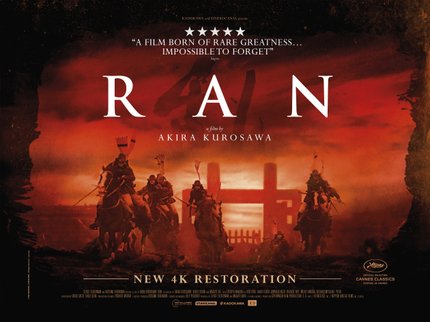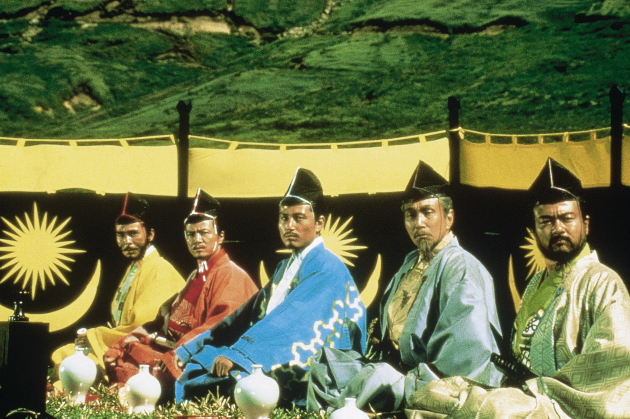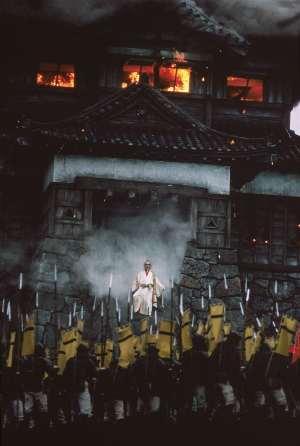Review: Kurosawa's RAN, 4K Restoration DVD/Blu-ray Release

One morning, several years ago, I finished an interview with a documentary filmmaker at a little café within the cavernous underground of the Tokyo train station.
The political nature of the film, combined with the fact the station was on high alert because US President Barack Obama had been in town, heightened the claustrophobic feeling within those tunnels and I was happy to emerge onto the street. Exiting that vast maze from a small side exit, I entered into the bright sunshine of a crisp Tokyo morning to find a pleasant little book fair.
Happily, I did what comes naturally to a book hoarder and film-nut; I scoured the shelves for anything movie related. What I found were two full-color volumes of Kurosawa Akira’s paintings for Ran. I’d seen some of these paintings before in an exhibition but never realized there were so many, featuring vivid depictions of samurai and horses and castles and war colored in Conte crayon, gouache, watercolor and Sumi. The colors bled from the page and the images, rough and energetically drawn as they were, screamed of movement and life. From the modern world of politics, I was thrust into an ancient one, of a samurai warlord and his scheming sons.
Kurosawa’s critical and commercial peak may have occurred entirely in black and white, from 1950’s Rashomon until 1965’s Red Beard, but thanks to its profound use of color, the director’s work arguably never looked as striking as it does here. Restored and re-released to coincide with its 30th anniversary, as well as the 400th anniversary of the death of William Shakespeare, Ran is the last great masterpiece from one of the world’s greatest directors.
Staggeringly, if it were not for foreign investment the film may have never been made at all. As journalist and author Michael Brooke details in his Disc 2 interview, the great director had suffered a string of setbacks after the release of Red Beard, the last hit of his staggeringly successful golden age run.
A twice-failed stab at Hollywood, first with The Runaway Train and then Tora! Tora! Tora!, had left Kurosawa consumed with production difficulties for a five-year period before he finally returned to Japan to make Dodesukaden. A commercial failure, the director found himself out of favor with Japanese studios, winding up in Russia for his next feature, Dersu Uzala.
An Academy Award for Best Foreign Feature didn’t change the fact that neither Toho, the studio he had produced so many hits for, nor any other major studio would cough up the money for his lavish and lengthy productions. Out of work and out of cash, the artist went to work producing thousands of drawings to storyboard a script he had written with Throne of Blood co-writer Masato Ide. With drawings in hand and help from Francis Ford Coppola and George Lucas the samurai epic Kagemusha was made. But Kagemusha, impressive though it was, was considered by Kurosawa to be a dry run for what would quite possibly be his final work: Ran.
 The film starts when a hunting party ends and a gathering begins. It is warlord Hidetora Ichimonji’s arrow that felled the hunted animal, a man who has earned his position from a lifetime of brutal battles and the vicious acts that accompany them. Joining the drinking party are Ichimonji’s three color-coded sons, yellow-clad eldest Taro, red middle-son Jiro, and blue Saburo. Lords Fujimaki and Ayabe are also present. Saburo’s facetious humor earns the scorn of his brothers and risks insulting the two guests but when the great warlord falls asleep Saburo, in a textbook ‘Save the Cat’ moment, remains behind to cut a branch from a tree in order to shelter his father from the sun.
The film starts when a hunting party ends and a gathering begins. It is warlord Hidetora Ichimonji’s arrow that felled the hunted animal, a man who has earned his position from a lifetime of brutal battles and the vicious acts that accompany them. Joining the drinking party are Ichimonji’s three color-coded sons, yellow-clad eldest Taro, red middle-son Jiro, and blue Saburo. Lords Fujimaki and Ayabe are also present. Saburo’s facetious humor earns the scorn of his brothers and risks insulting the two guests but when the great warlord falls asleep Saburo, in a textbook ‘Save the Cat’ moment, remains behind to cut a branch from a tree in order to shelter his father from the sun.
When Ichimonji awakens, he has decided to retire from his position, leaving his main castle to his eldest son, with the second and third castles going to Jiro and Saburo. He then proceeds to teach the sons of the strength of their family bond: he gives each son an arrow, which they snap easily, however, the bundle of arrows that follows next cannot be so easily broken.
Saburo, who is concerned about his father’s decision, disrupts the lesson by breaking the bundle upon his knee. Enraged, the loyal son is banished. It is here that Ran's loose identification with the narrative of Shakespeare’s King Lear is most evident, whilst historical elements, like the aforementioned arrow breaking scene, are also woven into the narrative.
 It is not long before Hidetora's new arrangement begins to unravel. The Lord Ichimonji, played by Nakadai Tatsuya, returning from his starring role in Kagemusha, soon finds himself passed from castle to castle as the film sets the scene for its stunning centerpiece: a lengthy siege in which the armies of Taro and Jiro descend upon the castle in which their father has taken shelter.
It is not long before Hidetora's new arrangement begins to unravel. The Lord Ichimonji, played by Nakadai Tatsuya, returning from his starring role in Kagemusha, soon finds himself passed from castle to castle as the film sets the scene for its stunning centerpiece: a lengthy siege in which the armies of Taro and Jiro descend upon the castle in which their father has taken shelter.
Bold, graphic images of bloodied bodies, volleys of arrows, and terrified women forced into desperate acts of suicide are intercut with shots of light descending from the clouds of a gray sky. The light from heaven doesn’t reach the ground as God doesn’t care for the foolish acts of man and so blood continues to be shed as the suddenly very audible score accompanies the horrific vison.
When the warlord eventually staggers from his prison, dark shadow and heavy makeup have created an impressionistic mask of despair upon his face. The once great warlord has fallen into madness.
Further tragedy follows thanks to the machinations of the Lady Macbeth-like wife of Taro, Kaede. The now mad king will come to rely on the help of those whose lives he has ruined before a final shot at reconciliation with the son he spurned presents itself.
Ran was shot over six months and employed a cast of hundreds of horse-riding extras in full samurai regalia for its epic battle scenes. The siege scene, as detailed in the documentary contained with this release, was a one-shot affair with no room for error as the full-size castle set was burned to the ground.
Ran is an exceptional piece of filmmaking whose astounding mix of aesthetics and action are never prioritized over the films themes. The word ‘Ran’ translates as ‘chaos’, and it offers just that; a tragedy on the folly of man in which lives are left in ruin for the sake of power, greed and revenge.
Studio Canal’s new two-disc DVD release hosts a fine selection of extras alongside the beautifully restored restoration. The centerpiece is AK, Chris Marker’s 75-minute behind-the-scenes documentary on the making of the film. The film lets the images do the talking, showing the cast and crew at work whilst the narrator offers a gentle meditation on the nature of the great director’s filmmaking style.
Interviews with actress Harada Mieko, director of photography Ueda Masaharu and journalist Michael Brooke offer insight and anecdotes, while a stage appearance at Tokyo International Film Festival 2015 throws up this gem from Nakadai Tatsuya: “After four hours in makeup, Kurosawa says 'no shooting today'. But why? I ask. 'I have a hangover.'” The Blu-ray also includes features, "Akira Kurosawa: The Epic and the Intimate", "Akira Kurosawa By Catherine Cadou", "Art of the Samurai" and "The Samurai".
Ran will be screened in the UK as part of the ‘Shakespeare on Film’ retrospective at the BFI Southbank until 31st May. It is now available on EST, DVD, and Blu-ray.







